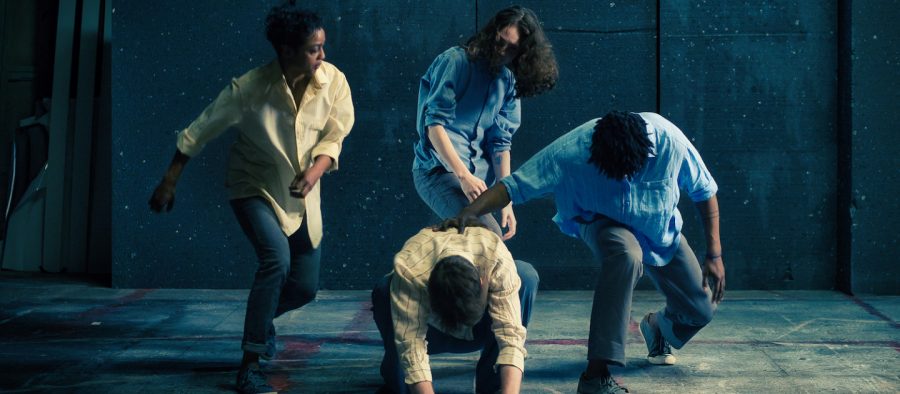Coming Together, Coming Undone: Review of Liz Roche’s “Yes and Yes” Performance
Courtesy of Liz Roche Performance Company
“Yes and Yes” premiered on Sept. 13.
September 21, 2022
As the lights went down in the Topper Theater this past Tuesday evening, the words “Sound of fans and gulls, traffic and sea” trailed across a digital screen in a red font above the stage. A singular dancer walked into view, their feet planted on the ground in front of them and their careful breaths were the only sounds to be heard. One could hear a pin drop in the room as the full theater watched the dancer smack their own face, dance across the room and lap circles as if directionless yet determined to get somewhere, running late to a place they cannot remember. This is the beginning of the Liz Roche Company’s performance of “Yes and Yes.”
Inspired by the book “Ulysses,” which celebrated 100 years since its initial publication this year, this commissioned performance from Artistic Director Liz Roche follows Ulysses, a Northern Irishman, through his personal odyssey to get home as though he is a Greek warrior and not an ordinary Irishman. Roche seamlessly shares the text through a vibrant contemporary dance featuring four dancers (Mufutau Yusuf, Sarah Cerneaux, Grace Cuny and Diarmuid Armstrong) not only in its entirety as a tangible text, but also as an experience of artistic vulnerability and a testament to the timeless nature and heart of Dublin, Ireland and its people.
The enigmatic and at times mind-bending imagery is an absolute wonder to behold, as the dancers mold their bodies around one another, blurring the lines between body and body, boundary and boundary. Images and text flash overhead, many magnifying motifs of industrialization and biblical influences. Some parts of the story are bewildering to see on stage, particularly if you are not intimately familiar with “Ulysses.” Some students who attended expressed confusion and even discomfort in their lack of knowledge and how unmoored they felt during some of the particularly abstract or bizarre scenes.
“I went last night and was honestly confused,” Rachel Reiniger said. “I didn’t have any prior knowledge on the show or the company, and it definitely wasn’t what I was expecting. It was noticeably uncomfortable at times, but I think this is intentional.”
All the same, the students expressed a fascination with the execution of the show, noting the clear exhibitions and displays of love and loss. The audience as a whole was caught off-guard many times throughout the experience, especially during an infamous brothel scene, in which the dancers contort around one another in various sexual positions while wearing floral morph suits, once again blurring lines between their bodies and their realities, this time playing into a larger dialogue of the natural beauty and magnificence of Ireland.
When the show ended, nearly the entire audience was on their feet, cheering and applauding, and the majority stayed after for an introduction to and short interview with Liz Roche herself by Joseph Lennon, the Emily C. Riley Director of the Irish Studies Department.
When asked how she was approached for the project, Roche reflected, saying, “[They said], ‘How about ‘Ulysses?’’ and I thought, ‘Maybe not.’”
The whole audience burst out laughing at such a statement, recognizing Roche is beaming with joy and pride in the production we have all just witnessed.
“The book really supported you to take a risk,” Roche said during the interview.
Roche went on to explain that this commissioned piece is a challenge, but one ultimately worth tackling. She delved into how much she marveled at the motifs they were able to translate from the text into movement, such as the constant dislocation movements of various body parts as a visual representation of disconnect and/or exile from the self and from the larger picture. When drawing up parallels between her work and Jame Joyce’s original text, Roche said,“A lot of the dance is a stream of consciousness.”
Throughout this performance, Roche truly lived up to her reputation as a “restless artist.” “Yes and Yes” explores not only the story of Ulysses, but of home – the loss and rediscovery of it, whether it is within the friends we meet on the journey, a certain place or ourselves. The messages of “Ulysses,” even one hundred years after publication, ring true and are deeply felt across generations, even when communicated across mediums. Such an aid to clarity and self-reflection is a rare but powerful gift, and to witness it in Roche’s work, knowing it symbolizes a raw and uniquely human experience felt even a century later is a privilege. As Lennon put it, “You helped us see it all.”


